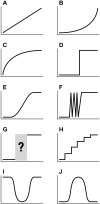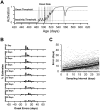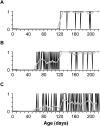What is the shape of developmental change?
- PMID: 18729590
- PMCID: PMC2654330
- DOI: 10.1037/0033-295X.115.3.527
What is the shape of developmental change?
Abstract
Developmental trajectories provide the empirical foundation for theories about change processes during development. However, the ability to distinguish among alternative trajectories depends on how frequently observations are sampled. This study used real behavioral data, with real patterns of variability, to examine the effects of sampling at different intervals on characterization of the underlying trajectory. Data were derived from a set of 32 infant motor skills indexed daily during the first 18 months. Larger sampling intervals (2-31 days) were simulated by systematically removing observations from the daily data and interpolating over the gaps. Infrequent sampling caused decreasing sensitivity to fluctuations in the daily data: Variable trajectories erroneously appeared as step functions, and estimates of onset ages were increasingly off target. Sensitivity to variation decreased as an inverse power function of sampling interval, resulting in severe degradation of the trajectory with intervals longer than 7 days. These findings suggest that sampling rates typically used by developmental researchers may be inadequate to accurately depict patterns of variability and the shape of developmental change. Inadequate sampling regimes therefore may seriously compromise theories of development.
Copyright (c) 2008 APA, all rights reserved.
Figures





References
-
- Adolph KE. Learning in the development of infant locomotion. Monographs of the Society for Research in Child Development. 1997;62(3) Serial No. 251. - PubMed
-
- Adolph KE. In: Lockman J, Reiser J, editors. Learning to learn in the development of action; Action as an organizer of learning and development: The 32nd Minnesota Symposium on Child Development; Hillsdale, NJ: Lawrence Erlbaum Associates. 2005.pp. 91–122.
-
- Adolph KE, Berger SE. Motor development. In: Kuhn D, Siegler RS, editors. Handbook of child psychology (6th ed., Vol. 2: Cognition, Perception, and Language. John Wiley & Sons; New York: 2006. pp. 161–213.
-
- Adolph KE, Badaly D, Garciaguirre JS, Sotsky R. 15,000 steps: Infants’ locomotor experience. 2008. Manuscript in preparation.
-
- Adolph KE, Vereijken B, Shrout PE. What changes in infant walking and why. Child Development. 2003;74:474–497. - PubMed

